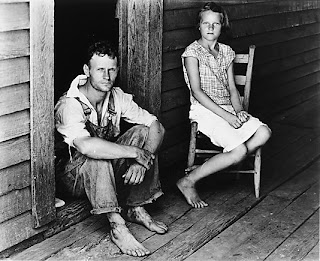Walker Evans, Floyd and Lucille Burroughs on Porch, Hale County Alabama, 1936.
Walker Evans captured the life of the commoners in America during the great depression. Agee and Walker traveled the states trying to see what life was really like during these hard times. In this photo, the dirty bare feet show not only a lack of shoes, but that the father was a worker in the fields. You can see the sweat that has plastered the father's hair back. Trying to sustain his family, this photo definitely describes what the book states as: "showing the terrible economic deprivations of the Great Depression of the 1930's."
As I looked at more of Walker Evans photos, I thought of Charlie Chaplin's film Modern Times and the social message that it carried. Photography, like film, also can send a social message and give an understanding to others without a single word. While the subjects of this photograph are dirty and wearing old raggedy clothes, Evans seems to have found the beauty despite the hardship. His use of lines and shadow is pleasant to the eye when looking at this image. The placement of his subjects helps the eye know where to start and finish. His photographic eye helped to capture not just a documentation of how life really was, but beautiful images that are worth thousands of dollars.
As I looked at more of Walker Evans photos, I thought of Charlie Chaplin's film Modern Times and the social message that it carried. Photography, like film, also can send a social message and give an understanding to others without a single word. While the subjects of this photograph are dirty and wearing old raggedy clothes, Evans seems to have found the beauty despite the hardship. His use of lines and shadow is pleasant to the eye when looking at this image. The placement of his subjects helps the eye know where to start and finish. His photographic eye helped to capture not just a documentation of how life really was, but beautiful images that are worth thousands of dollars.







